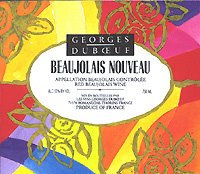
Finally the day where every decent wine lover would be waiting for! The arrival of the Beaujolais Nouveau 2005! I have managed to get hold of this young wine in Isetan Scotts today at a price of SGD27.90! I have tried the 2003 bottle which to me was a smashing fruity wine. At that time, my cousin went all the way to Africa to get me a bottle.
For those who wish to know more about the wine. Here are some information.
Extracted: From a wine enthusiast
"This Wednesday (16 November), starting at about 10 p.m., quite a few of us will be standing in line at wine stores, bars and restaurants, empty glasses in hand, waiting to taste the Beaujolais Nouveau wines that will be poured precisely at midnight. We will not be alone, for at midnight their own time people in New York, San Francisco, Paris, Hong Kong, Melbourne, Soeul, Singapore and Rio de Janeiro will also be waiting for a sip of these super young wines. "
Extracted: intowine.com
AT ONE MINUTE PAST MIDNIGHT on the third Thursday of each November, from little villages and towns like Romanèche-Thorins, over a million cases of Beaujolais Nouveau begin their journey through a sleeping France to Paris for immediate shipment to all parts of the world. Banners proclaim the good news: Le Beaujolais Nouveau est arrivé! "The New Beaujolais has arrived!" One of the most frivolous and animated rituals in the wine world has begun.By the time it is over, over 65 million bottles, nearly half of the region's total annual production, will be distributed and drunk around the world. It has become a worldwide race to be the first to serve to this new wine of the harvest. In doing so, it has been carried by motorcycle, balloon, truck, helicopter, Concorde jet, elephant, runners and rickshaws to get it to its final destination. It is amazing to realize that just weeks before this wine was a cluster of grapes in a growers vineyard. But by an expeditious harvest, a rapid fermentation, and a speedy bottling, all is ready at the midnight hour.
Beaujolais Nouveau began as a local phenomenon in the local bars, cafes, and bistros of Beaujolais and Lyons. Each fall the new Beaujolais would arrive with much fanfare. In pitchers filled from the growers barrels, wine was drunk by an eager population. It was wine made fast to drink while the better Beaujolais was taking a more leisurely course. Eventually, the government stepped into regulate the sale of all this quickly transported, free-flowing wine.In 1938 regulations and restrictions were put in place to restrict the where, when, and how of all this carrying on. After the war years, in 1951, these regulations were revoked by the region's governing body—the Union Interprofessional des Vins de Beaujolais (UIVB)—and the Beaujolais Nouveau was officially recognized. The official release date was set for November 15th. Beaujolais Nouveau was officially born. By this time, what was just a local tradition had gained so much popularity that the news of it reached Paris. The race was born. It wasn't long thereafter that the word spilled out of France and around the world. In 1985, the date was again changed, this time to the third Thursday of November tying it to a weekend and making the celebration complete. But wherever the new Beaujolais went, importers had to agree not to sell it before midnight on the third Thursday of November.
On a more technical note, the wine is strictly speaking, more properly termed Beaujolais Primeur. By French and European rules, a wine released during the period between its harvest and a date in the following spring, is termed primeur. A wine released during the period between its own and the following years harvest, is termed nouveau. Well, enough of that! It is a triumph of marketing and promotion, mostly due to the efforts of
Georges Dubœuf. The largest negociant in the region, he is a tireless promoter of Beaujolais and Beaujolais Nouveau. More than a fifth of his annual production, about 4 million bottles, is Beaujolais Nouveau. All in all, in the last 45 years, sales have risen from around a million bottles to more than 70 million bottles. Apart from the fanfare, what makes Beaujolais Nouveau so popular? And especially in the U.S. where consumption of red wine is less than 30%? Simply put, Beaujolais Nouveau is as about as close to white wine as a red wine can get. Due to the way it is made—the must is pressed early after only three days—the phenolic compounds, in particular the astringent tannins, normally found in red wines, isn't there, leaving an easy to drink, fruity wine. This, coupled with the fact that it tastes best when chilled, makes for a festive wine to be gulped rather than sipped, enjoyed in high spirits rather than critiqued. As a side note, it makes a great transitional wine for anyone wanting to move from white to red wines.
 Franck Duboeuf presided over the official uncorking at New York.
Franck Duboeuf presided over the official uncorking at New York.






